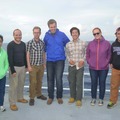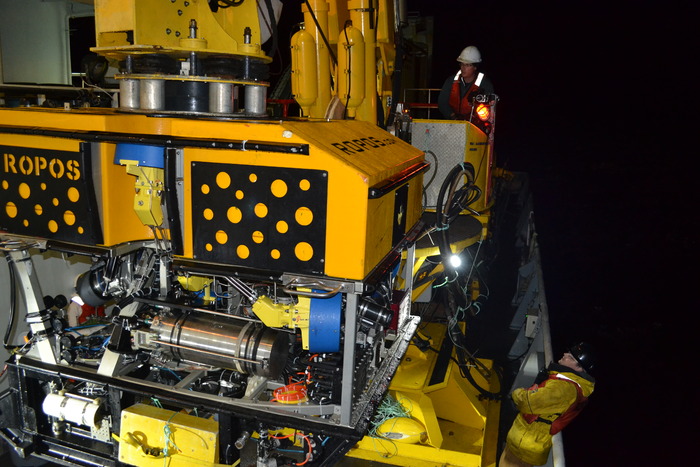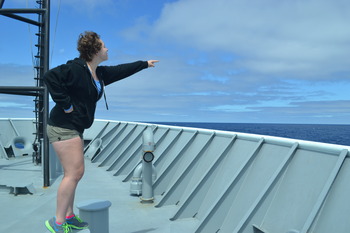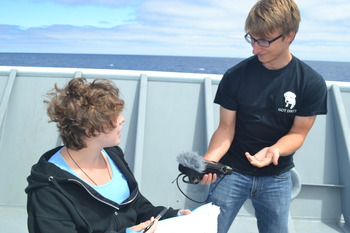10 August 2014
It’s Sunday. We’re transiting home. So sad! I will miss the open ocean, but hopefully we’ll be reunited soon. So everyone was scrambling to get projects done, because the only two things on the schedule today were presentations at two and live streamed interviews at five. Presentations went well, but people are in a lot of different places in terms of how complete their projects are. I felt pretty good about mine, and at 7min there’s still a fair amount of editing that I could do, but overall it was pretty complete. A couple hours later we were each taken, in pairs, to tell our live stream audience what we’ve been doing this whole cruise. It was short and sweet, albeit a little awkward. There was a weird lag on the camera and a screen showing what was being shot, it was a little distracting. And it kept us from dinner, so we all just wanted to be done with it. The last exciting thing of the evening was poetry night, lead by John. It’s amazing how many poems he can recite from memory they are really quite beautiful. He’s both a scientist and an artist. It’s a nice dichotomy as opposed to the world of arts vs science that seems to plague the university. Finally, a few of my shipmates and I watched this God-awful movie called Bug. Don’t watch it, not worth it. We lost a few students to seasickness, but I’m feeling good! Woot!
8/9 August 2014
Holy cow, the last two days have been busy! The most exciting thing happened! In lieu of the problems we’ve been experiencing with the Deep Profiler, we have received permission from NSF to plug into the primary infrastructure. This is the first major step to providing data back to shore and John Delaney is delighted, as is the rest of the science crew. So on Friday we recovered the rest of the deep profiler. ROPOS dropped down to about 100m and hooked a line onto the big orange float at the top of the system and returned that line to the Thompson where they could put it through the complicated steps necessary to recovery everything. While this was occurring I was finally able to get an interview with Skip Denny, the chief engineer of RSN, to talk about seismometers. Then I video-edited. The project is due on Sunday! That’s coming too soon! On Saturday, we steamed over to the caldera of Axial and plugged everything into the primary node. This is HUGE for the project, and marks the beginning of data streaming. Now, the kinks in the data stream and how these data will be presented on a website still need to be sorted out, but step one has been taken. After plugging in, we went back to Axial’s base to redeploy the now repaired Deep Profiler and plug it in! This was completely successfully, much to the relief of the profiler team and the ROPOS pilots. Everything is wrapping up nicely, and though we didn’t get everything done that was planned on this cruise, we’ve had a lot of troubleshooting, excitement, and revolutionary science. I’m proud to be a part of it. Buuuut I still need to work on my video. Because I’m presenting tomorrow.
7 August 2014
Today was the day for ROPOS. In for a 24 hour dive. The morning and early afternoon went well. The dive was going well, I was able to import the IRLS footage necessary for my video project, and I took about an hour today to enjoy some sun out on the deck. I still hadn’t gotten the interview with Skip that I wanted, but my plan was to ask him after my watch in the evening when things were slowing down and the ROV was scheduled for an hour long cable crawl. Turns out the transit wouldn’t happen for much longer.
The ocean had been calm and exceptionally beautiful today. The sun was warm and the breeze just enough to keep you cool. As I gathered myself and heading into the dark control room, little did I know that a storm would soon hit almost 3000m underwater. ROPOS had just moved a flange box, which had cable coiled in it, near the Deep Profiler anchor. The plan for the next hour was for ROPOS to take the cable that had been laid, move 7m up the anchor chain, and connect this cable to the deep profiler docking station. What seemed like a simple task turned into six hours of setback, problem solving, and the decision to recover the deep profiler system. The docking station had not been engineered to take into consideration that ROPOS would need to hold onto it directly by the cable connector. The docks position between the anchored chain and the line with the float high above made it impossible to steady the dock into a position where the fiber optic cables would connect at the right angle with the right amount of force. There was always a part that would move. Ironically, today there was a ship BBQ, and while the crew was outside enjoying the sun and good food, the ROPOS control room was packed with very distressed engineers and scientists. It wasn’t a very festive occasion. The decision to pull the profiler was made after my watch, but it sets us back two days and the plan for the rest of the cruise is unclear. I think we’re going to bring the system back up, alter the dock, and try again. In the meantime, projects are due in three days. Everything is going to come down to the wire in the next couple of days.
6 Aug 2014
Day 6 at Sea
The HPIES deployed this morning early, and when I woke up ROPOS was on its way up. Today is an exciting day! The Deep Profiler was officially deployed late this afternoon, and we were witness to a little piece of oceanography history. The deployment was a complex process, involving a lot of line tension transfers when different parts of the system entered the water. The profiler went in anchor first, followed by the acoustic releases for recovery purposes. The big parts of the system included the electronics hull, which is known as the deep profiler dock and is where the cable laid yesterday will plug in, the actual crawler, which takes data readings, and eventually, the crawler stopper and buoy. The whole process went incredibly smoothly, and for a first time deployment it was amazing that nothing major seemed to go wrong. The moral on the ship is high, as we’re on schedule.
Our lecture today was on the electronics present in the secondary nodes and corresponding junction boxes. Our presenter, James, is an electrical engineer from APL, and has played a large part in the designing of the nodes. In the secondary nodes, there are three types of junction boxes, or j-boxes, that can be rigged off of the nodes. There are low power, low voltage, and mid power j-boxes. We talked a bit about the sensors that could come off each of these, as well as the physical designs of the corresponding electronics boards.
With the script for my project complete, today was the day that I recorded the narration that I wrote. I took my computer to the library with a recorder provided by Ed and talked through what I had written on my computer. I felt it went smoothly, and had mentally patted myself on the back. When I listened back to the recording I had made I realized that I wasn’t that good…. Holy monotone. It was sooo boooring! To gain to narration inspiration, I watched some Blue Planet, because David Attenborough is the man with the golden voice. Later I took another stab at recording, and though it wasn’t perfect, it was a hell of a lot better than it had been. I’ll continue to tweak it, but I know time is running out.
The students did a bit of socializing this evening after the excitement of the Deep Profiler Deployment. We watch the first episode of I think season 5 of Doctor Who. I’d never seen it before and I could see why so many people are intrigued by it. I tried my hand at darts and finished one of my cups, a crab that I’m particularly proud of. I’ve been staying up later and later on this cruise, it’s a dangerous trend. With the projects being due on Sunday, I think I’ll see several more late nights.
5 Aug 2014
Day 5 at Sea
You get into a rhythm on the ship. Wake up in the morning, head upstairs to the lab to work, hang out on deck watching equipment operations, read in the library or hang out in the lounge, and eat in the galley. All the excitement centers on ROPOS. It’s a scheduled yet comfortable way of living, but the days seem to blur together and it’s getting harder and harder to discern what day it is. I just know that we’re already half way done and I don’t want to even think about getting off this vessel.
ROPOS put down another junction box this morning. During my watch shift we laid cable down. It’s interesting to see how much goes into a cable lay. The cable is measured and marked to every half layer, and those layers are supposed to correspond with marks on a map of the sea floor. If the wraps are off from where the markers are, it can indicate a difference in tension. The directional and speed that the cable goes out then must be adjusted and marked. It’s interesting to watch, and our job was to note observation of cable wraps, whenever the vehicle passed a marker, and anything interesting that shows up during the operation. This cable is being laid for the first deep profiler to every be used in ocean sciences. Everyone is getting antsy about the impending installation. The deep profiler is essentially a sensor box that crawls up and down a cable from the bottom of the ocean to just about 300m under the surface. It’s a bit like a science elevator, looking at conductivity (salinity), temperature, oxygen, and optical backscatter (biology). Hopefully those will be going in tomorrow.
The script for my movie has been completed! Now I just need to fit in an interview with the every busy Skip Denny, and learn how to actually make videos. I remain wary of the quickly approaching end ofd the cruise, but optimistic.
4 Aug 2014
Day 4 at Sea
The morning started late today. We had begun our transit to the Axial Seamount from Slope Base late last night, and there was no rush to get any work done immediately. I leisurely took the day to catch up on blogs, outline a script for my video and check how doable it was with Ed, our cameraman on board, and met with John to fact check some of my geology facts. He gave me a book to read called Full Rip 9.0 by Sandi Doughton, about the last big quake of the PNW, the research that went into studying the seismology of the area, and how another big quake could affect the region. I learned that the famous Japanese painting of the giant wave was from a tsunami in the year 1700 that came from a magnitude earthquake on the Cascadia Fault Line. It’s some scary stuff for the greater Seattle area.
We had a nice lecture midafternoon about the deep profilers, which will be deployed at both slope base and the base of axial. And I spent some time on deck after and worked on some cups. After dinner I took a quick nap, and after we had arrived on station, Sam Rachel and I did a work out. The rest of the evening was uneventful; ROPOS went into the water around 9:30 and dropped a junction box. This site has a busy dive schedule, so there should be plenty of action over the next few days.
3 Aug 2014
Day 3 at Sea
Today when I woke up ROPOS was in the water finishing up it’s mission from the previous night. The day was productive, but overall uneventful until the evening. I spent the morning finishing up a work project and was able to talk to the Chief Engineer of the science party, Skip, about the seismometers on the project, the differences between them and the importance they have in the establishment of a more accurate and sensitive monitoring system for earthquakes. I also learned that though there is six hours worth of initial data from some seismometers put down from last cruise, there will be no streamed data until later in the summer. With that information I decided that my project will be an outreach video on the importance of seismic monitoring and why the RNS project will provide important and necessary data for a continued understanding of earthquakes. Our lecture today was with Mike, a scientist from OSU who looks at deep-sea organisms. The stuff that lives in the bottom of the ocean is crazy and it’s very clear that there is still a lot we don’t know; yet another reason why this project is so important for new understanding of the abyssal plane ecosystem.
The evening was extra exciting because I had my FIRST OFFICIAL WATCH TODAY! ROPOS went in the water at about 6:00, and we watched as it descended into the depths of the ocean. Specifically to the primary node situated at about 2900m deep. We weren’t on watch long enough to see it hit the bottom, but as we passed about 300m we saw a ton of fishes, a squid, some jellyfish, and organisms that I wasn’t familiar with. Though the amount of life diminished the deeper we went, it was astounding how much was still there. The marine snow was incredible; there were little salps and other squishy organisms the entire way down. On occasion, little animals would get sucked into ROPOS’s thrusters… that was both sad and interesting. My job was to record interesting things that we saw on the decent on the IRLS system so we have a log for the video.
When my watch was over at 8:00, I was just in time to watch the sun set on the Pacific. There’s nothing like a good sunset to tie up a good day of science. There was also a bit of bow jumping, where the ship became our personal antigravity machine. We’re expecting the weather to deteriorate in the next twelve hours, so as soon as ROPOS is up and out of the water, likely around 1:00 tonight, we’re steaming 18 hours to Axial. You can already feel the swells getting bigger. My plan for the night is to fall into a Dramamine coma and hunker down. I’ve had enough seasickness for one trip. Until tomorrow, Madison out!
2 Aug 2014
Day 2 at Sea
Today was our first full day at slope base. ROPOS had been scheduled for a dive but due to a problem with the arm, our first dive was pushed back 10 hours for repairs. Nonetheless it was a productive day. I was able to get some personal work done, and finished a couple more cups. The timing on the cups was good because we had a CTD go in for some yo yo casts. The yo yo casts, which is simply the CTD going up and down in the water column, allowed for a temperature, conductivity, and oxygen profile of our spot. Because we were stationary, but the current was moving around us, it allowed for some spatial data of the flow.
A student meeting was held after lunch where we talked about the academic responsibilities we all have while on the cruise. I need to solidify my project still. A couple hours after our student meeting John Delaney gave us a lecture on the Ocean Observation Initiative, gave us an introduction to the sites we will be working on. Outreach will be an important part of this project as we depend on public support of the project.
Not too much more happened today. I experienced the challenges of working out on a ship. Depending on what your doing and the pitch of the ship, things like pushups become very easy or very hard. That was fun. We saw a whale spout from afar, but we couldn’t really see the whale. It’s beautiful out here and I’m adjusting to the constant rocking well. ROPOS went in after my shift, so I peeked in a couple times to see what was going on. Sam, my watch partner, and I were all ready to work but while ROPOS was trying to mate with a package a latch didn’t fit right. It was fixed, but after our shift so I still haven’t had an official watch yet. Hopefully I’ll get one soon!
1 Aug 2014
Day 1 at Sea
I am sad. I am so sad. I have dreamed of being one of those godlike mariners—the ones immune to seasickness. I am not. We left Newport at around 10:30, and I was bright eyed and bushy tailed, ready to set out on the scientific adventure that is the Ocean Observation Initiative. The first 10 minutes were great, smooth sailing, flat water and a light breeze. As we quickly passed the rocky edge of the harbor a thick layer of fog surrounded us as the ship began to heave. Shortly after so did I. I was trying to stay functional on deck by trading time on deck and taking a number of naps varying in length. At one point during the day we were brought into the computer room to learn about the ROPOS video logging system. I think I lasted about five minutes before running (well, not actually because that’s not allowed on the ship) to the fantail and tossing my cookies over the side. By this point the waves were hitting the starboard side of the ship, where I had positioned myself, and the water would crash onto the deck. I came out of this experience a little on the damp side, but I did feel better. And went back to sleep.
When we arrived to our first station slope base, where the edge of the continental shelf ends, the rocking was much less. As we had been transiting out we were headed west and the swells were coming from the North resulting in the uncomfortable roll alongside the pitching of this ship. This ended when we stopped and pointed our bow north. I took solace in the fact that I wasn’t the only one who was sick, and that the weather was poor enough to delay operations. So I started drawing on Styrofoam cups, to shrink them! I brought enough for everyone and there has since been art galore. While I was in the main lab drawing with some of my shipmates, we were alerted to the fact that there were literally thousands of hydrozoan jellyfish called Velella velella. They resemble Portuguese Man of Wars, but much smaller. They have little short tentacles and a sail that allows them to travel with the wind. They’re quite beautiful, and have a vibrant blue coloration. Rachel, my new friend and fellow biology enthusiast, and I procured a bucket and collected a couple of them for samples. We wanted to examine stomach contents but we don’t have a dissecting scope. Currently they’re still in the bucket and we’re trying to decide what to do with them.
Later in the evening when the weather calmed down we ended up doing a late night dive with ROPOS, where I watched a bit of the descent. There is so much life in the ocean; it’s absolutely incredible. I’m excited for future dives and just being a part of this project. When I get a turn at a watch I’ll have much more information about the creatures of the deep and development of my project. In the meantime I just hope I don’t get seasick anymore.





